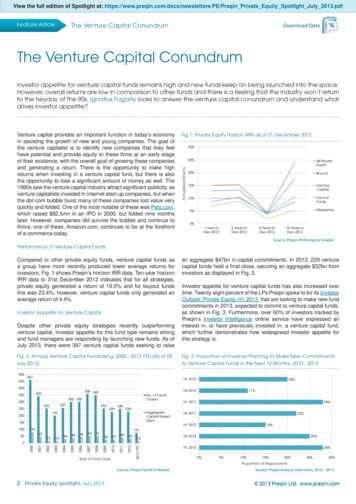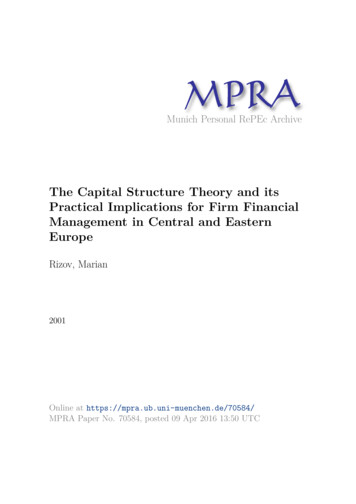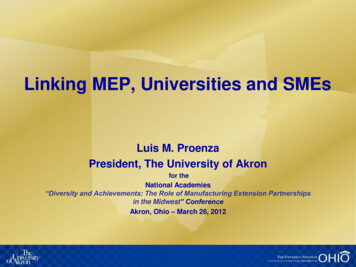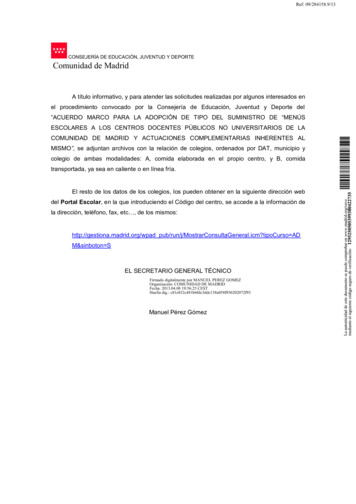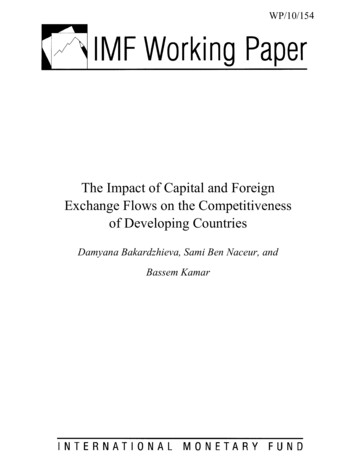
Transcription
WP/10/154The Impact of Capital and ForeignExchange Flows on the Competitivenessof Developing CountriesDamyana Bakardzhieva, Sami Ben Naceur, andBassem Kamar
2010 International Monetary FundWP/10/154IMF Working PaperIMF InstituteThe Impact of Capital and Foreign Exchange Flows on theCompetitiveness of Developing CountriesPrepared by Damyana Bakardzhieva1, Sami Ben Naceur, and Bassem Kamar2Authorized for distribution by Abdelhadi YousefJuly 2010AbstractThis Working Paper should not be reported as representing the views of the IMF.The views expressed in this Working Paper are those of the author(s) and do not necessarily representthose of the IMF or IMF policy. Working Papers describe research in progress by the author(s) and arepublished to elicit comments and to further debate.Attracting capital and foreign exchange flows is crucial for developing countries. Yet, theseflows could lead to real exchange rate appreciation and may thus have detrimental effects oncompetitiveness, jeopardizing exports and growth. This paper investigates this dilemma bycomparing the impact of six types of capital and foreign exchange flows on real exchangerate behavior in a sample of 57 developing countries covering Africa, Europe, Asia, LatinAmerica, and the Middle East. The results reveal that portfolio investments, foreignborrowing, aid, and income lead to real exchange rate appreciation, while remittances havedisparate effects across regions. Foreign direct investments have no effect on the realexchange rate, contributing to resolve the above dilemma.JEL Classification Numbers: C23, F2, F31, F41Keywords:Real Exchange Rate, Competitiveness, Capital Flows, Developing Countries,FDI, Foreign Exchange Flows, Panel Data Econometrics, Emerging Markets.Author’s E-Mail Address: bakardzhieva@econ.umd.edu; sbennaceur@imf.org;bkamar@imf.org1University of Maryland-College Park, Morrill Hall 1106D, College Park, MD 20742.IMF Institute, International Monetary Fund, 700 19th Street, N.W., Washington, D.C. 20431.We thank Enrica Detragiache, Dalia Hakura, Luca Ricci, Nikola Spatafora and Abdelhadi Yousef for usefulcomments, and Yasmina Zinbi and Naseebah Hajjaj for editorial assistance.2
2CONTENTSPAGEI. Introduction .3II. Capital Flows and the Real Exchange Rate Nexus: Related Literature .5III. Capital Flows and Other REER Determinants.9A. REER Index .9B. Capital and Foreign Exchange Flows Variables .10C. Control Variables .12Government Consumption .12Trade Openness .12Productivity .12Terms of Trade .13IV. Empirical Methodology .13V. Interpretation of the Results .14VI. Conclusion and Policy Implication .20References .26TABLES1. GMM-in System Estimates of the Impact of Capital Flows on Real Effective .162. GMM-in System Estimates of the Impact of Capital Flows on Real Effective by Region .183. Capital and Foreign Exchange Flows to the CEECs in percent of GDP .24FIGURES1. REER for all Six Regions Including GCC .212. Aggregated Capital Flows.213. Income.214. Aid.225. Aid in All Regions Excluding GCC.226. Remittances .227. FDI .238. Portfolio Investments .239. Portfolio Investments Excluding GCC .2310. Debt .2411. Debt Excluding GCC .24APPENDIXES1. List of Countries Included in our Sample .252. List of Variables Included in our Model .25
3I. INTRODUCTIONMaintaining a high level of competitiveness is an important objective for developing andemerging economies, as it enhances their exports and growth and contributes to theireconomic diversification3. Therefore, investigating the determinants of competitiveness andidentifying the factors that might undermine them is essential.Competitiveness can have different measures, including labor productivity, the real effectiveexchange rate (REER), unit labor cost, terms of trade, Balassa's index of revealedcomparative advantage, and the World Economic Forum competitiveness index. The paperuses the real effective exchange rate (REER)4 as it has been the most widely used measurefor competitiveness in the literature in recent years5.Capital flows are an important determinant of the possible loss of competitiveness. Most ofthe related literature indicates that an increase in capital flows leads to the appreciation6 ofthe real effective exchange rate (REER), which may have detrimental effects on the externalcompetitiveness (Corden, 1994).On another hand, capital flows are essential for developing and emerging markets. Theycontribute to enhancing investments and financing current account deficits. This dual effectcreates a dilemma for policy makers on how to manage capital inflows to maximize thebenefit for the economy.Resolving this dilemma requires identifying which capital flows lead to the least significantappreciation of the REER, or have no impact on the REER at all, and thus do not necessarilyundermine competitiveness. Capital flows can be divided into several types. Three distinctiveflows appear in the financial account of the balance of payments, namely foreign directinvestments (FDI), portfolio investments and other investments. Three others appear in thecurrent account — remittances, aid, and income. While these flows are not typically labeledas “capital” flows, their implications for competitiveness could be significant. These flowsare referred to in the paper as “foreign exchange” flows.3Though competitiveness is not a goal in itself, relatively fast growing countries need improvedcompetitiveness to sustain high output growth without straining the balance of payments, (e.g. Lipschitz andMcDonald, 1991).4This paper uses the IMF REER Index.5See for example Eyraud (2009), Bennett and Zarnic (2008) and Monfort (2008). Nevertheless, as with allother proxies, using REER as an indicator for competitiveness could have some limitations. For example, aslong as relative productivity rises faster than the percentage appreciation of the REER, competitiveness canimprove even as the REER appreciates.6It should be noted that the paper’s analysis of the appreciation or depreciation of the REER cannot tell whetherit is a misalignment or an equilibrium phenomenon.
4The related literature reveals a disparity in the impact of the different types of capital flowson competitiveness, and even a disparity in the impact of specific types of capital flowsacross countries and regions. The impact depends on the types of expenditure each flow istied to. For example, a long-run increase in aid or in remittances devoted to povertyalleviation will likely generate increased spending on non-tradables, and an increase in therelative price of non-tradables (i.e. REER appreciation). Conversely, if an increase in, say,FDI or natural-resource revenues is spent mainly on imported capital goods, then it may beless likely to lead to REER appreciation, but this does not translate into greater externalsustainability7.In addition, while FDI, aid and remittances attracted the focus of researchers in this field,other flows like portfolio investments, other investments and income witnessed very limitedor no attention. One can argue that the impact of any of these three flows on REER alsodepends on the types of expenditure each flow is tied to. If portfolio investments flows areoriented towards the modernization of firms in developing countries, which requires newmachinery and new product lines, the impact might be similar to that of FDI, but if they aremainly volatile investments for speculation, the impact might be different.The same applies to other investments flows in the financial account of the balance ofpayments. These flows can be either liabilities of the private or the public sector of theeconomy. If these flows are to be used to build golf courses, their impact on REER might bedifferent than if they are used to finance exports production, which would be also differentthan if the flows are used to finance non-tradables like building houses.Concerning income flows in the current account, their impact on REER might be lessobvious. While one might think they would lead to the appreciation of REER like capitalflows in general, in some cases like those of the rich oil countries with wealth funds, it ispossible that income received from investments is reinvested abroad and should then have noimpact on the REER. Because of all these possibilities of having mixed results, we find itvery interesting to examine the impact of each of these capital flows on REER, and alsocompare their impact across different regions.The contribution of this paper lies in comprehensively examining the effect of eachdistinctive capital and foreign exchange flow on the REER in various geographical regions.8The review of the empirical literature shows that earlier studies were confined to fewer typesof flows and were also restricted to single countries or to limited country groups.To our knowledge, this paper is the first attempt to fill this gap by investigating this issue in alarge set of developing countries. The estimations in the paper are conducted on a panel of 57countries covering 6 regions, namely Africa, Central and Eastern European Countries7For an extensive study on real exchange rate assessment and external sustainability in low income countriessee Christiansen et al. (2009).8We want to underline that the main objective of the paper is to identify the degree to which each type ofinflow affects the REER. The details on why FDI or remittances might affect the REER differently or on whyaid might have different impacts across regions are beyond the scope of this research.
5(CEEC), South and East Asia, Latin America, Middle East and North Africa (MENA), andthe Gulf Cooperation Council (GCC).9The Generalized Method of Moments (GMM) estimator is used to examine the relationshipbetween each type of capital and foreign exchange inflow and REER appreciation. Thisestimator has the advantage of dealing with omitted variable and endogeneity biases, oftenpresented as two sources of inconsistency in the literature on REER and capital flows.The most significant finding of the paper is that FDI does not lead to the appreciation ofREER in almost all regions and even leads to its depreciation in the CEEC and MENA. Thismakes a strong case for implementing policies encouraging FDI which might improvedeveloping countries’ competitiveness and mitigate the overall negative impact of aggregatedcapital flows on REER appreciation.The next section summarizes the main findings available in the literature related to theimpact of different types of capital flows on the REER. Section III presents the theoreticaldeterminants of the REER behavior and explores each type of capital flow across the sixregions. Section IV discusses the appropriateness of the GMM estimator approach anddescribes the econometric methodology. Section V presents the results, and Section VIconcludes.II. CAPITAL FLOWS AND THE REAL EXCHANGE RATE NEXUS: RELATED LITERATUREThe Salter (1959), Swan (1960), Corden (1960) and Dornbusch (1974) paradigm serves asthe theoretical underpinning to test empirically the incidence of capital flows on the REER inemerging economies. The model explains how a surge in capital flows would generate anappreciation of the REER (Corbo and Fisher, 1995). A rise in capital flows increases realwages, which in turn bring out a rise in domestic demand and hence in prices of nontradablegoods relative to tradable goods that are exogenously priced. Since the REER is generallydefined as the value of domestic prices of nontradable goods relative to prices of tradablegoods, a rise in the relative price of nontradable goods corresponds to a real exchangeappreciation (spending effect). This is indicative of the presence of “Dutch Disease effects”(Corden and Neary, 1982), which describes the side effect of natural-resource booms orincreases in capital flows on the competitiveness of export-oriented sectors and importcompeting sectors. However, different types of capital flows may have different effects onthe REER because they affect it through different channels.9While the GCC are part of the MENA region, they are analyzed separately in the paper because of the specificnature of their economies and the possible unique impact capital and foreign exchange flows in these countriescan have on the REER. By contrast with other regions, remittances and aid are mainly outflows, and incomeinflows are the result of large and increasing oil-revenue investments abroad.
6REER determinants have been the subject of numerous theoretical and empiricalinvestigations and are widely used to estimate the REER equilibrium and its misalignment.Capital flows are included as a determinant in most of the studies (Aron et al., 1998,Elbadawi and Soto, 1997, and many others). However, recent studies have tried to assess theimpact of capital flows per se on the REER as a measure of competitiveness. Some of themdistinguish FDI and other capital flows, some have concentrated on specific foreignexchange flows, such as aid and remittances, and some have interacted capital flows witheconomic policy variables.Capital Flows: FDI, Portfolio Investments, Other Investments (Debts)For the papers related to the impact of foreign direct investment (FDI) versus other flows,Athukorala and Rajapatirana (2003), in a study of countries in Latin America and South andEast Asia, find that non-FDI capital flows lead to real exchange rate appreciation (to a fargreater degree in Latin America than in East Asia), while FDI tends to depreciate the realexchange rate. The authors explain their findings by the hypothesis that FDI tends to be morebiased toward tradable goods compared with the other types of capital flows. Lartey (2007)reveals that FDI causes the REER to appreciate in Sub-Saharan Africa but to a lesser extentcompared with aid flows, which is similar to a “Dutch Disease effect.”The impact of portfolio investment and other investments (debt) flows on REER seems tohave received little attention so far. Elbadawi and Soto (1994) disaggregate capital flows forthe case of Chile into four components: short-term capital flows, long-term capital flows,portfolio investment, and foreign direct investment. They find that short-term capital flowsand portfolio investment have no effect on the equilibrium real exchange rate, but long-termcapital flows and foreign direct investment have a significant appreciating effect.Foreign Exchange FlowsTo our knowledge, the analysis of the relation between REER and income flows that appearin the current account has been so far relatively neglected. Analyzing this variable isincreasingly important from our point of view. Many developing countries are accumulatingreserves and are creating large wealth funds to manage their accumulated surpluses. This isthe case not only in oil rich countries, but also in China and some other countries. The returnfrom these wealth-funds’ investments abroad appears in the income account of the balance ofpayments. As current account surpluses in these countries increase, wealth-fund investmentsgrow and the income flows rise. The impact of this rise in income on the REER depends onwhether these revenues are tied to local or foreign goods consumption and on how suchflows would affect the price of non-tradables. The impact also depends on possible nominalexchange rate appreciation, which could be subject to the existing exchange rate regime andto the sterilization of exchange rate interventions. The significance and sign of the impact ofincome on REER in our tests will be informative about the channels through which incomeaffects economic activity in different regions.
7For the studies focusing on workers’ remittances, several papers confirmed the presence of alarge spending effect that causes a rise in relative prices of nontradables and REERappreciation, producing a “Dutch Disease effect.” Amuedo-Dorantes and Pozo (2004) findthat doubling the transfers of workers’ remittances leads to an appreciation of the REER by22 percent in a panel of 13 Latin American countries. In the same vein, Lopez et al. (2007)confirm that surges in remittances cause the REER to appreciate in Latin America. Thefindings also indicate that the observed changes in the REER are driven not solely by naturalappreciation but that some changes are linked to misalignment. More recently, Lartey et al.(2008) show that an increased level of remittances in developing countries can lead to REERappreciation. The study also finds that the “Dutch Disease effect” is more acute in thepresence of fixed exchange rate regimes.Rajan and Subramanian (2005) study the impact of remittances and find that they have noeffects on external competitiveness. They explain this surprising result by the argument thatremittance flows are mainly directed toward unskilled-labor activities and tradable sectorssuch as manufacturing. Their analysis also concludes that aid flows have systematic adverseeffects on a country’s competitiveness, as reflected in a decline in the share of labor intensiveand tradable industries in the manufacturing sector. They find evidence suggesting that theseeffects stem from the real exchange rate overvaluation caused by aid flows.Following-up on aid flows in a multi-country setting, Elbadawi (1999) finds that a 10 percentincrease in the aid flows contributes to a rise of 1 percent in the REER in a panel study of 62developing countries. Later on, Elbadawi et al. (2008) using a behavioral real exchangemodel on a sample of 83 countries between 1970 and 2004 find that although post-conflictcountries receive larger aid flows, they exhibit moderate REER overvaluation. Along thesame line, Prati and Tressel (2006) find in a sample of developing countries that foreign aidflows have a negative impact on exports of poor countries as implied by the “Dutch Disease”theory.IMF (2005) reports on an absence of appreciation of the exchange rate in five Africancountries following the surge of aid flows. The study concludes that part of the reason thatreal appreciation (and consequently, Dutch disease) was not observed in those cases isprecisely because authorities were concerned with competitiveness and restricted aidabsorption accordingly. Adenauer and Vagassky (1998) find that aid contributes substantiallyto real exchange appreciation in the countries of the West African Economic and MonetaryUnion. For a large sample of developing countries, Kang et al. (2007) find that aid flowshave a negative effect on exports linked to REER overvaluation for half the sample and apositive impact on growth and exports for the other half of the sample. Fielding (2007) alsoreaches the same mixed results when using a conditional VAR for ten Pacific economies toassess whether aid flows lead to real exchange appreciation.
8More recently, Arellano et al. (2009) find that higher aid flows are associated with a higherrelative price of nontradables and thus a real appreciation. In a study covering 73 aiddependent countries, they explain that aid increases the availability of tradables relative tonontradables, raising the equilibrium price of the latter. At the same time, it pushes up thereturns to capital, the factor assumed to be used intensively in nontradable production, thusincreasing the relative cost of producing nontradables. Yet, they also emphasize that no realappreciation would occur if the capital stock were freely interchangeable between sectors.Gupta et al. (2005) demonstrate that the impact of aid flows on the REER depends on theuses of aid, its contents, and its assumed policy response. If foreign aid is spent on imports,there is no effect on the REER. However, if the proceeds are sold by the government to thecentral bank, the impact on REER will depend on how much the central bank will sell of theaid-related foreign exchange in the domestic market and on how much of this amount oflocal currency counterpart is spent domestically. Adam and Bevan (2004) and Nkusu (2004)point out that the more elastic the supply response, the smaller the real exchange appreciationneeded, which emphasizes the mitigating role of excess output capacity. Atingi-Ego (2005)confirms the above argument in finding that excess capacity in the nontraded sector of someAfrican countries limits the potential of price increases stemming from aid flows.Additionally, Adam and Bevan (2004) demonstrate that the reaction of the REER to aidflows depends on the variation of the composition of aid expenditures.For individual country studies, White and Wignaraja (1992) conclude that aid flows havecaused REER appreciation in Sri-Lanka. Opoku-Afary et al. (2004) examine the case ofGhana using vector autoregression (VAR) econometric modeling and find no short-runeffect, but the impact of aid in the long run is strong and conducive to real exchangeappreciation. More recently, Bourdet and Falck (2006) find that aid flows in the Cape VerdeIslands cause some REER appreciation with an elasticity of less than 10 percent.Both Falck (1997) and Nyomi (1998) examine the impact of aid flows on the REER inTanzania. While Flack’s ordinary least squares (OLS) estimation indicates real exchangeappreciation, Nyomi’s error correction model finds, to the contrary, that foreign aid generatesdepreciation in the REER.The literature review reveals several gaps in the analysis of the impact of the different typesof capital and foreign exchange flows on competitiveness. In addition, there are ambiguousand sometimes contradictory results regarding the effect of any of the disaggregated capitalor foreign exchange flows across countries, regions, and econometric methodologies. Thiscalls for further research on the subject.
9III. CAPITAL FLOWS AND OTHER REER DETERMINANTSIn order to investigate the impact of each type of capital flow on REER behavior indeveloping countries, we are applying our tests to 57 developing countries (Appendix 1),covering six different regions; Africa, CEEC, South and East Asia, GCC, Latin America andMENA. The capital flows and foreign exchange flows data are obtained from the balance ofpayments data reported in the International Financial Statistics. The data for other controlvariables are from the World Economic Outlook (WEO) database. The sample period is from1980 to 2007.The paper empirically examines the factors that influence the real effective exchange rate byestimating a number of variants of equation (1), depending on the assumption made about theerror term and the exogeneity of the independent variables:REERi,t α1 α2Capital Flowsi,t α3Policyi,t α4Controli,t εi,t(1)where i refers to the country and t refers to time.A. REER IndexREER indices for countries in the sample are obtained from the IMF’s Information NoticeSystem (INS) database.10Figure 1 examines the behavior of the REER across regions.11 The year 2000 is taken as acommon base year for comparison across all countries, even though it does not represent aparticular REER equilibrium level for any country or region.The REER depreciated over the period from 1980 to early 1990s for all regions. After that,REER stabilized in Latin America, the GCC, and Africa. Asia has seen a depreciation of theREER during the Asian crisis, and MENA shows a strong appreciation during the first Gulfwar in 1991. The CEEC presents a special case as the region witnessed a continuousappreciation of the REER since the economic transformation of the early 1990s.Section B below describes trends in the six types of capital and foreign exchange flows.Section C explains the definition of other determinants of the REER that are included in theregression estimations, including policy variables (monetary, fiscal, and trade-opennessvariables) and some other control variables, and their theoretical relationship with the REER.10Appendix 2 provides the definition and data sources for the variables used in the paper.Ghana is excluded from the calculation of the average REER for Africa because the index exceeded 3800 in1983, and constitutes an important outlier.11
10B. Capital and Foreign Exchange Flows VariablesThe calculation of the aggregated capital and foreign exchange flows (that we label netcapital flows or NKF) includes flows in both the current account (income, remittances, andaid) and the financial account (FDI, portfolio investments, and other investments). The sumof these six variables would be equal to the inverse sign of the balance of goods and servicesafter subtracting the change in reserves, to get only the total capital and foreign exchangeflows without any central bank intervention.The net capital flows in the different regions have been following close trends, except for thecase of the GCC (Figure 2). While the other five regions witnessed positive capital flowsover the period from 1980 to 2007, the GCC had an opposite pattern, with massive capitaloutflows reaching almost 27 percent of GDP, especially in recent years. The year 1991 is anexception owing to the first Gulf war and represents a recurrent outlier in almost all datarelated to the GCC.The MENA region seems to have attracted the highest ratio of NKF to GDP over the period,oscillating on average between 10 and 20 percent. The second region is Africa, joined by theCEEC by the end of the period. South and East Asia and Latin America received the lowestNKF/GDP that oscillated between /- 5 percent.Next the paper analyzes the various types of flows, starting with the current account flows(income, aid, and remittances), followed by the financial account flows (FDI, portfolioinvestments, and debt).The GCC enjoyed the highest level of income to GDP over the sample period (Figure 3),reaching almost 18 percent in the early 1980s. This could be due to the investment of oilrevenue abroad that allowed the GCC countries to receive high returns in their incomeaccount. In almost all other regions, income was negative, reflecting higher amounts ofinterest paid on debt than returns on investments.The second variable is the public official current transfers. It is referred to in the paper asAID and is calculated as a percentage of GDP (Figure 4). Figure 5 excludes the GCC becauseof their outlier in 1991, to allow us to better visualize the aid flows in the other regions. Itshows that Africa received the highest ratios of aid to GDP, reaching more than 6 percentin 1993, followed by MENA, CEEC since 1992, Latin America, and finally South and EastAsia.The third flow variable in the current account is the private unilateral transfers to GDP ratioand is a proxy for remittances. All regions except the GCC have seen increasing or stableremittances flows to their economies (Figure 6). Owing to the nature of the GCC economies,which rely mainly on foreign labor, these countries face constant remittances outflowsbetween 5 and 10 percent of GDP.
11The MENA countries are the most important recipients of remittances, reaching more than5 percent of GDP since the early 1990s, followed by Africa at 3 percent, South and EastAsia, Latin America, and CEEC.With respect to the flows in the financial account, FDI flows to developing countries, havebeen increasing steadily over the past three decades. Figure 7 shows that the level of FDI toGDP has been lower than 2 percent in the 1980s and started to pickup in the beginning ofthe 1990s. Since the second half of the nineties, the CEEC were on average
exchange rate (REER), unit labor cost, terms of trade, Balassa's index of revealed comparative advantage, and the World Economic Forum competitiveness index. The paper uses the real effective exchange rate (REER)4 as it has been the most widely used measure for competitiveness in the literature in recent years5.



